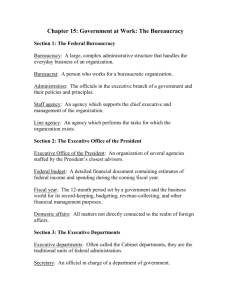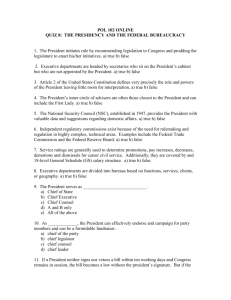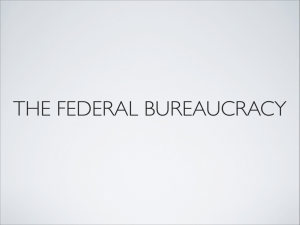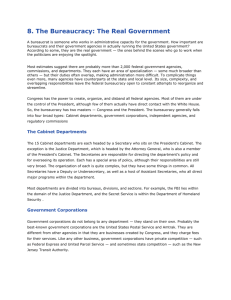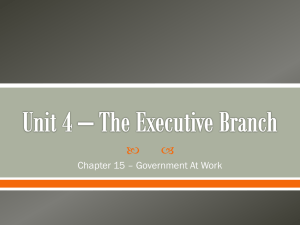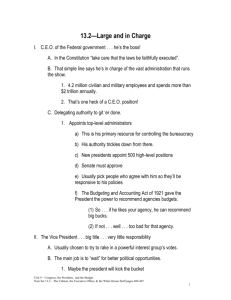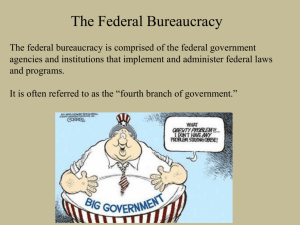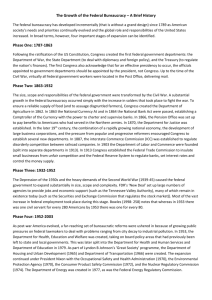Chapter 13: The Bureaucracy
advertisement
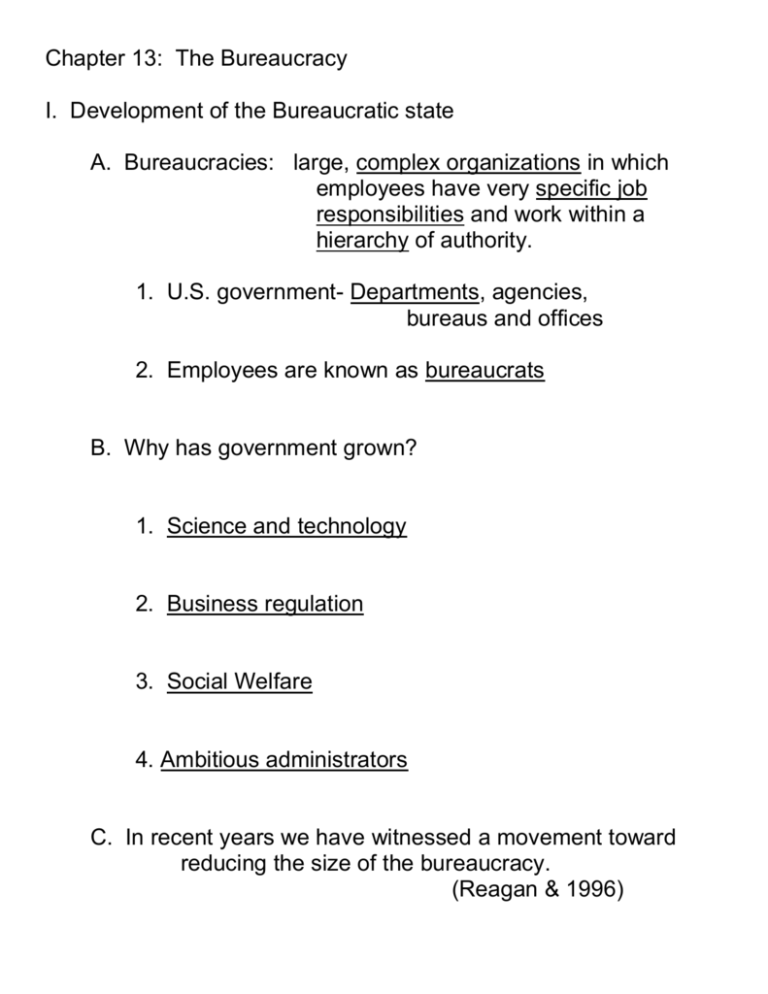
Chapter 13: The Bureaucracy I. Development of the Bureaucratic state A. Bureaucracies: large, complex organizations in which employees have very specific job responsibilities and work within a hierarchy of authority. 1. U.S. government- Departments, agencies, bureaus and offices 2. Employees are known as bureaucrats B. Why has government grown? 1. Science and technology 2. Business regulation 3. Social Welfare 4. Ambitious administrators C. In recent years we have witnessed a movement toward reducing the size of the bureaucracy. (Reagan & 1996) 1. difficult to do because different segments of the population work hard to protect the programs that serve them. 2. National government has reduced the number of bureaucrats it employs without reducing government programs. This is accomplished by contracting these functions out to private employers. 3. Tension between Majoritarianism and pluralism The broader public wants government reduced. Those who benefit organize and mobilize to protect programs and agencies they value. II. Bureaus and Bureaucrats A. Departments are the largest units of the executive branch a. secretaries lead these departments b. there are currently a total of 15 departments Minority appointments 1) 1st woman – Frances Perkins Secretary of Labor 1935-1945 appointed by FDR 2) 1st African American- Robert C. Weaver Secretary of HUD 1966 Appointed by LBJ 3) first president to appoint a woman and African American Appointed by Ford -1975 B. Independent Agencies are not a part of the cabinet. a. some are controlled by the White House ex. CIA b. some are structured as regulatory commissions (ex. FCC) and were formed to guard against unfair business practices. c. The president influences them through the appointment of new commissioners. C. Government Corporations (ex. Postal Service, Amtrax) a. created because Congress felt the public would be better served if the government runs them. D. Bureaucrats are hired under the requirements of the civil service. a. civil service created due to the assassination of President Garfield b. created to reduce patronage in the awarding of federal jobs c. jobs are filled on the basis of merit, and workers can not be fired due to political reasons d. 2.9 million civilians are employed That’s 2% of the U.S. workforce e. most civil servants work outside of Washington D.C. E. Presidents appoint about 7,000 people to jobs in his administration. a. That’s less than 1% of all executive branch employees b. Some appointments are campaign workers, but most are drawn from business, universities, and government itself. c. about 700 of his appointments require senate confirmation. (majority) d. presidents would like to fill a larger number of positions in government, especially Republicans because they feel government workers have a liberal bias. THE PRESIDENT’S CABINET *The President’s cabinet is NOT mentioned in the Constitution *It is a product of Custom and Usage The first Cabinet was created by President Washington in 1789 It contained 4 Departments 1) 2) 3) 4) State- Secretary Thomas Jefferson Treasury- Secretary Alexander Hamilton War (today it’s called Defense)- Secretary Henry Knox Justice- Attorney General Randolph Today the cabinet has 15 Departments The Cabinet Secretaries are appointed by the President and confirmed by a majority of the Senate. Of the more than 600 appointments only 12 have been turned down Qualifications of Cabinet members: (Nothing is written but the following are usually followed) *someone who played a part in the president’s campaign *professional qualifications and practical experience in the department they are to be secretary *sectional balance *Gender and race *management abilities and experience Roles played by the Cabinet Members 1) administrative head of a department 2) advisor to the president Administrative Policymaking: The Formal Processes The freedom that Congress gives agencies to make policy in the spirit of their legislative mandate is called: Administrative Discretion For example: When Congress created The Department of Homeland Security They knew there were problems with security in the U.S., but the Department heads would decide how best to implement new policies to safeguard Americans from terrorism. Often a problem is clear cut, but a solution is not. Citizens complain these agencies have too much power and others complain these agencies can’t get anything accomplished because of “Red Tape” Congress usually gives vague directives instead of setting guidelines for these agencies. So…… How does Congress rein in Agencies with too much power? 1. Create more laws to limit their powers 2. Reduce the amount of money the agency gets “Power of the Purse” 3. Informal meetings between legislators and administrators What is Rule Making? First the agencies create proposals so all interested parties (Congress, business owners etc.) can take a look at the proposals. The creation of regulations are controversial because they often force people and business to act in certain prescribed ways, often against their own self interest. Agency rules are supposed to follow laws passed by Congress. These regulations have the effect of law!!! “Muddling Through” 1) Consider all possible solutions to a problem 2) In the real world, do you always have time to do this????? NO 3) Therefore, the solutions are not always thought through thoroughly. (say that 10 times!) 4) What problems are faced when creating policy? a. b. c. d. It’s hard to define values and goals selecting the most effective means to a desired end is not usually possible Problems are often too pressing to wait for a complete study Policymaking tends to be incremental (changed bit by bit with trial & error)—Affordable Care Act “BY THE BOOK” Bureaucrats must go by the book(follow laws), or they can be held liable in court. You also leave yourself open to favoritism if you don’t go by the book. If bureaucrats made their own rules we would have chaos and no one on the same page. IMPLEMENTATION Putting policies into action! Converting policies from words on paper into action. Many factors influence the implementation of policies: a. Vague Directives create a source of difficulty b. The complexity of some policies is problematic c. Faulty coordination occurs when Jurisdiction overlaps Example: The Federal Building was bombed in Oklahoma Who has jurisdiction??? Trial and Error usually lead to policies that work! Reforming the Bureaucracy 1. making government smaller or less intrusive 2. Fighting waste in government Four basic approaches 1. Deregulation: reduce the government’s role and let the natural market forces of supply and demand take over 1970’s and 80’s airlines, trucking, telecommunication industries and financial services 2. Competition & Outsourcing Allow non-profits(tax exempt) to be created thus reducing social services the government is providing Outsource government jobs to the private sector through biddings 3. TQM- Total Quality Managementtreat citizen’s like “customers" 4. Government Performance and Results Act***** “making the managers manage” holding the agencies accountable for their performance!!!!!!! Chapter 13: The Bureaucracy I. Development of the Bureaucratic state A. Bureaucracies: 1. U.S. government- ________________________, agencies, bureaus and offices 2. Employees are known as_____________________ B. Why has government grown? 1. 2. 3. 4. C. In recent years we have witnessed a movement toward ____________________ the size of the bureaucracy. 1. 2. National government has _____________________the number of ______________________it employs without reducing government programs. This is accomplished by _____________________ these functions out to _______________________ employers. 3. Tension between Majoritarianism and pluralism II. Bureaus and Bureaucrats A. Departments are the ___________________________of the executive branch a. _________________________ lead these departments b. there are currently a total of _______ departments THE PRESIDENT’S CABINET *The President’s ____________________________________________ *It is a product of _____________________________________ The first Cabinet was created by President Washington in 1789 It contained _____ Departments 1) _____________- Secretary Thomas _________________ 2) _____________- Secretary Alexander ____________________ 3) ____________ (Today it’s called Defense)Secretary Henry Knox 4) _____________- Attorney General Randolph Today the cabinet has 15 Departments The Cabinet Secretaries are Appointed by the President and Confirmed by a ________________of the ____________. Of the more than _________ appointments only ____ have been turned down Qualifications of Cabinet members: (nothing is written but the following are usually followed) *someone who played a part in the president’s ________________ *______________________________ and practical experience in the department they are to be secretary *___________________ balance *_____________________________ *management abilities and experience Roles played by the Cabinet Members 1) Administrative head of a department 2) ________________ to the president Minority appointments 1) 1st woman –________________________ Secretary of Labor 1935-1945 appointed by FDR 2) 1st African American- Robert C. Weaver Secretary of HUD 1966----Appointed by LBJ 3) First president to appoint a woman and African American Appointed by ____________ -1975 B. ______________________ are not a part of the cabinet. a. some are controlled by the White House ex. ______________ b. some are structured as __________________ commissions (ex. FCC) and were formed to guard against unfair business practices. c. The president influences them through the appointment of new_________________. C. ________________________(ex. Postal service, Amtrax) a. D. Bureaucrats are hired under the requirements of the ________________________. a. civil service created due to the assassination of President ____________________ b. created to reduce patronage in the awarding of federal jobs c. jobs are filled on the basis of ______________, and workers can not be fired due to political reasons d. __________ million civilians are employed That’s ____% of the U.S. workforce e. E. Presidents appoint about ________________________ people to jobs in his administration. a. That’s less than _______% of all executive branch employees b. Some appointments are campaign workers, but most are drawn from ______________________________________________ c. about ________ of his appointments require_____________________. d. presidents would like to fill a larger number of positions in government, especially Republicans because they feel government workers have a liberal bias. Administrative Policymaking: The Formal Processes The freedom that Congress gives agencies to make policy in the spirit of their legislative mandate is called: ________________________ For example: When Congress created The Department of Homeland Security They knew there were problems with security in the U.S., but the Department heads would decide how best to implement new policies to safeguard Americans from terrorism. Often __________________________________________________________ Citizens complain these agencies have too much power and others complain these agencies can’t get anything accomplished because of “___________” Congress usually gives ______________________________________________ for these agencies. So…… How does Congress rein in Agencies with too much power? 1. __________________________to limit their powers 2. Reduce the amount of money the agency gets “_______________________________” 3. ________________________between legislators and administrators What is Rule Making? First the agencies _________________________so all interested parties (Congress, business owners etc.) can take a look at the proposals. The creation of regulations are controversial because they often force people and business to act in certain prescribed ways, often against their own self interest. Agency rules are supposed to follow laws passed by Congress. These____________________________________________!!! “__________________________________” 1) ___________________________________________to a problem 2) In the real world, do you always have time to do this????? NO 3) Therefore, the solutions are not always thought through thoroughly. (say that 10 times!) 4) What problems are faced when creating policy? a. It’s hard to define values and goals b. selecting the most effective means to a desired end is not usually possible c. _________________________________________________________ d. Policymaking tends to be _______________________________ (changed bit by bit with trial & error) “________________________________” *Bureaucrats must go by the book(follow laws), or they can be held liable in court. *You also leave yourself open to favoritism if you don’t go by the book. *If bureaucrats made their own rules we would have chaos and no one on the same page. ___________________________________ Putting policies into action! Converting policies from words on paper into action. Many factors influence the implementation of policies: a. _____________________________create a source of difficulty b. The complexity of some policies is problematic c. Faulty coordination occurs when ______________________ overlaps Example: The Federal Building was bombed in Oklahoma Who has jurisdiction??? __________________________________usually lead to policies that work! Reforming the Bureaucracy 1. making government smaller or less intrusive 2. Fighting waste in government Four basic approaches 1. ____________________: reduce the government’s role and let the natural market forces of supply and demand take over 1970’s and 80’s airlines, trucking, telecommunication industries and financial services 2. _______________________________________ Allow ____________________ (tax exempt) to be created thus reducing social services the government is providing ________________government jobs to the private sector through biddings 3. TQM- _________________________________________treat citizen’s like “________________________" 4. _____________________________________________ “making the managers manage” holding the agencies accountable for their performance
